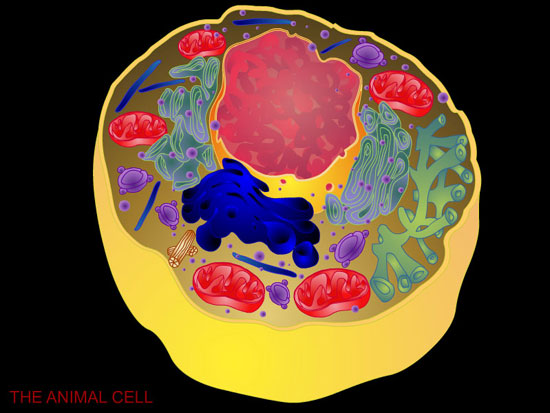Animal cell

Organelles in a typical animal cell.
typical animal cell,cell organelles,nuclear pores,cell membran,eukaryotic cells,cell image,deoxy,ribonucleic acid,filaments,respiration,nucleus,dna
- ID: 16087
- Source: DNALC.DNAi
Related Content
16647. Higher cells incorporate an ancient chromosome.
DNAFTB Animation 30: Ivan Wallin presents his idea that mitochondria and chloroplasts were once free-living organisms.
1022. Pathways, Inside the nucleus
In this section learn that an activated protein is transported into the nucleus through a pore in the nuclear membrane.
16877. Cell Signals
Journey inside a cell as you follow proteins and learn about cellular interactions. This 3-D animation brings to life the inner workings of a fibroblast cell as it responds to external signals. Created by Cold Spring Harbor Laboratory and Interactive Know
16230. Gallery 7: Micrograph of Cell Dividing, 1
(1 of 4) Photomicrograph of a cell dividing: nucleus is visible as dark staining organelle.
15978. Mitochondrial DNA: a closer look
DNA found in the mitochondrion of a cell differs in structure and is separate from the DNA found in the cell nucleus. Mitochondrial DNA, or mtDNA, exists as a circular loop of double-stranded DNA rather than the linear form found in nuclear DNA. However,
1023. Pathways, Making the protein
In this section learn that in the cytoplasm, the messenger RNA is released from its carrier proteins and binds to a protein assembly complex called a ribosome.
16725. Animation 35: DNA responds to signals from outside the cell.
James Darnell explains how chemical signals turn eukaryotic genes on and off.
16229. All cells arise from pre-existing cells.
DNAFTB Animation 7: Walther Flemming explains the phases of mitosis.
16784. Animation 38: Development balances cell growth and death.
Leland Hartwell describes how cells regulate the timing of growth and cell division. Bob Horvitz and Mike Hengartner explain control mechanisms for cell death.
1021. Pathways, To the nucleus
In this section learn that many signaling pathways ultimately pass messages to the nucleus of a cell.












